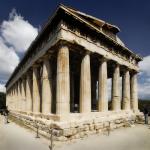|
This section contains 348 words (approx. 2 pages at 300 words per page) |

|
Aeschylus, Suppliants (462 B.C.E.)—The tragedy, the Suppliants by Aeschylus is the best surviving example of a drama that depends on the interpretative dancing of the chorus for its impact which in this instance, could have numbered as many as fifty instead of the usual fifteen members.
Apuleius, Metamorphoses (popularly known as "The Golden Ass," c. 180 C.E.)—The "Golden Ass," the only Latin novel to survive in its entirety, at Book 10.29–34, contains a description of a dance and pantomime production staged in Corinth.
Athenaeus, Deipnosophistae ("The Learned Men at a Banquet," c. 200 C.E.)—The Deipnosophistae, written in Greek by Athenaeus from Naucratis in Egypt, is an imaginary symposium where learned men discuss all manner of topics, and in both the first and fourteenth books, their topics include dancing. Athenaeus is a major source for modern knowledge of ancient dance...
|
This section contains 348 words (approx. 2 pages at 300 words per page) |

|



